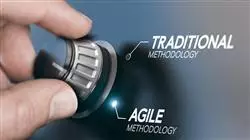University certificate
The world's largest school of business”
Introduction to the Program
With this 100% online Advanced master’s degree, you will efficiently manage logistics operations to increase organizational efficiency, reduce costs and improve market competitiveness”

Logistics is a fundamental element in the creation of value in modern companies. Therefore, strategic decisions affect all aspects of the operation, from procurement to distribution. However, with the increasing globalization of markets, companies must adopt flexible and efficient logistics models that adapt to a changing environment. Therefore, specialists need to have a comprehensive understanding of the assessment of Senior Logistics Management, with an approach based on strategic planning, technological innovation and supply chain management.
In this context, TECH has created a pioneeringAdvanced master’s degree in Senior Logistics Management. Designed by leaders in this field, the curriculum will delve into issues ranging from the fundamentals of executive management or the implementation in companies of latest-generation technologies such as big data to the most sophisticated techniques to optimize the distribution chain of products. Accordingly, graduates will obtain advanced technical competencies to efficiently manage logistics operations in a global and competitive environment.
On the other hand, the methodology of the university program is based on TECH's Relearning method, which guarantees the exhaustive assimilation of complex concepts. It should be noted that the only thing that professionals need to access this Virtual Campus is a device with Internet access, where they will find a variety of multimedia resources such as explanatory videos. In addition, renowned International Guest Directors will give exclusive Masterclasses.
Renowned International Guest Directors will give intensive Masterclasses that will provide you with the most innovative strategies to optimize the efficiency of Logistics Operations”
This Advanced master’s degree in Senior Logistics Management contains the most complete and up-to-date program on the market. The most important features include:
- The development of practical cases presented by experts in Senior Logistics Management
- The graphic, schematic, and practical contents with which they are created, provide scientific and practical information on the disciplines that are essential for professional practice
- Practical exercises where the self-assessment process can be carried out to improve learning
- Its special emphasis on innovative methodologies in financial practice
- Theoretical lessons, questions to the expert, debate forums on controversial topics, and individual reflection assignments
- Content that is accessible from any fixed or portable device with an Internet connection
TECH's characteristic Relearning system will allow you to learn at your own pace without depending on external teaching conditions”
It includes in its teaching staff professionals belonging to the field of Senior Logistics Management who pour into this program the experience of their work, as well as recognized specialists from leading companies and prestigious universities.
The multimedia content, developed with the latest educational technology, will provide the professional with situated and contextual learning, i.e., a simulated environment that will provide an immersive learning experience designed to prepare for real-life situations.
This program is designed around Problem-Based Learning, whereby the student must try to solve the different professional practice situations that arise throughout the program. For this purpose, the professional will be assisted by an innovative interactive video system created by renowned and experienced experts.
You will have comprehensive knowledge of supply chain management and best practices in logistics"

You will lead projects that optimize the sustainability, quality and resilience of logistics activities"
Why study at TECH?
TECH is the world’s largest online university. With an impressive catalog of more than 14,000 university programs available in 11 languages, it is positioned as a leader in employability, with a 99% job placement rate. In addition, it relies on an enormous faculty of more than 6,000 professors of the highest international renown.

Study at the world's largest online university and guarantee your professional success. The future starts at TECH”
The world’s best online university according to FORBES
The prestigious Forbes magazine, specialized in business and finance, has highlighted TECH as “the world's best online university” This is what they have recently stated in an article in their digital edition in which they echo the success story of this institution, “thanks to the academic offer it provides, the selection of its teaching staff, and an innovative learning method aimed at educating the professionals of the future”
A revolutionary study method, a cutting-edge faculty and a practical focus: the key to TECH's success.
The most complete study plans on the university scene
TECH offers the most complete study plans on the university scene, with syllabuses that cover fundamental concepts and, at the same time, the main scientific advances in their specific scientific areas. In addition, these programs are continuously being updated to guarantee students the academic vanguard and the most in-demand professional skills. In this way, the university's qualifications provide its graduates with a significant advantage to propel their careers to success.
TECH offers the most comprehensive and intensive study plans on the current university scene.
A world-class teaching staff
TECH's teaching staff is made up of more than 6,000 professors with the highest international recognition. Professors, researchers and top executives of multinational companies, including Isaiah Covington, performance coach of the Boston Celtics; Magda Romanska, principal investigator at Harvard MetaLAB; Ignacio Wistumba, chairman of the department of translational molecular pathology at MD Anderson Cancer Center; and D.W. Pine, creative director of TIME magazine, among others.
Internationally renowned experts, specialized in different branches of Health, Technology, Communication and Business, form part of the TECH faculty.
A unique learning method
TECH is the first university to use Relearning in all its programs. It is the best online learning methodology, accredited with international teaching quality certifications, provided by prestigious educational agencies. In addition, this disruptive educational model is complemented with the “Case Method”, thereby setting up a unique online teaching strategy. Innovative teaching resources are also implemented, including detailed videos, infographics and interactive summaries.
TECH combines Relearning and the Case Method in all its university programs to guarantee excellent theoretical and practical learning, studying whenever and wherever you want.
The world's largest online university
TECH is the world’s largest online university. We are the largest educational institution, with the best and widest online educational catalog, one hundred percent online and covering the vast majority of areas of knowledge. We offer a large selection of our own degrees and accredited online undergraduate and postgraduate degrees. In total, more than 14,000 university degrees, in eleven different languages, make us the largest educational largest in the world.
TECH has the world's most extensive catalog of academic and official programs, available in more than 11 languages.
Google Premier Partner
The American technology giant has awarded TECH the Google Google Premier Partner badge. This award, which is only available to 3% of the world's companies, highlights the efficient, flexible and tailored experience that this university provides to students. The recognition as a Google Premier Partner not only accredits the maximum rigor, performance and investment in TECH's digital infrastructures, but also places this university as one of the world's leading technology companies.
Google has positioned TECH in the top 3% of the world's most important technology companies by awarding it its Google Premier Partner badge.
The official online university of the NBA
TECH is the official online university of the NBA. Thanks to our agreement with the biggest league in basketball, we offer our students exclusive university programs, as well as a wide variety of educational resources focused on the business of the league and other areas of the sports industry. Each program is made up of a uniquely designed syllabus and features exceptional guest hosts: professionals with a distinguished sports background who will offer their expertise on the most relevant topics.
TECH has been selected by the NBA, the world's top basketball league, as its official online university.
The top-rated university by its students
Students have positioned TECH as the world's top-rated university on the main review websites, with a highest rating of 4.9 out of 5, obtained from more than 1,000 reviews. These results consolidate TECH as the benchmark university institution at an international level, reflecting the excellence and positive impact of its educational model.” reflecting the excellence and positive impact of its educational model.”
TECH is the world’s top-rated university by its students.
Leaders in employability
TECH has managed to become the leading university in employability. 99% of its students obtain jobs in the academic field they have studied, within one year of completing any of the university's programs. A similar number achieve immediate career enhancement. All this thanks to a study methodology that bases its effectiveness on the acquisition of practical skills, which are absolutely necessary for professional development.
99% of TECH graduates find a job within a year of completing their studies.
Advanced Master's Degree in Senior Logistics Management
Assertive leadership within an organization is given at the time of designing strategies that benefit the proper functioning of the flow of products in the acquisition of inputs, processing and distribution, in the same way, you must understand the importance of solving unforeseen situations and mitigate them as best as possible; all this has had an approach to employees and their needs, to make the processes ideal. Therefore, professionals immersed in this area should specialize in the necessary knowledge to establish one or more projects that meet the management methodologies and expected results, which is why TECH offers the Advanced Master's Degree in Senior Logistics Management so that graduates can stand out in the business sector both nationally and internationally. Finally, the method implemented is totally online, since the learning is based on the e-learning system, which allows flexibility in the time and place of study; it is only necessary to use any digital device such as a computer, a tablet or a smartphone.
Learn about Logistics Management online
This program is developed over two years and consists of more than twenty modules, in which you will delve into management and leadership, market research, global sourcing, performance and auditing, financial supply chain, socio-ecological impact, business and operations strategy, management methodologies, supply chain, international operations, contracting and project quality, among other topics. All of the above was designed with the objectives of strengthening management and leadership skills, as well as developing new competencies and skills that will be essential in professional development; and so, after the program, the student will be able to make global decisions with an innovative perspective. The faculty of the academic program stands out in the labor area, by which it is possible to transmit knowledge in terms of logistics, evidencing the need for coordination in terms of economic sectors, means of distribution, actions on business operations and suppliers; along with the basic processes within the company, which are central in the management of operations, thus being a learning based on the recognition of practice and academic rigor.







